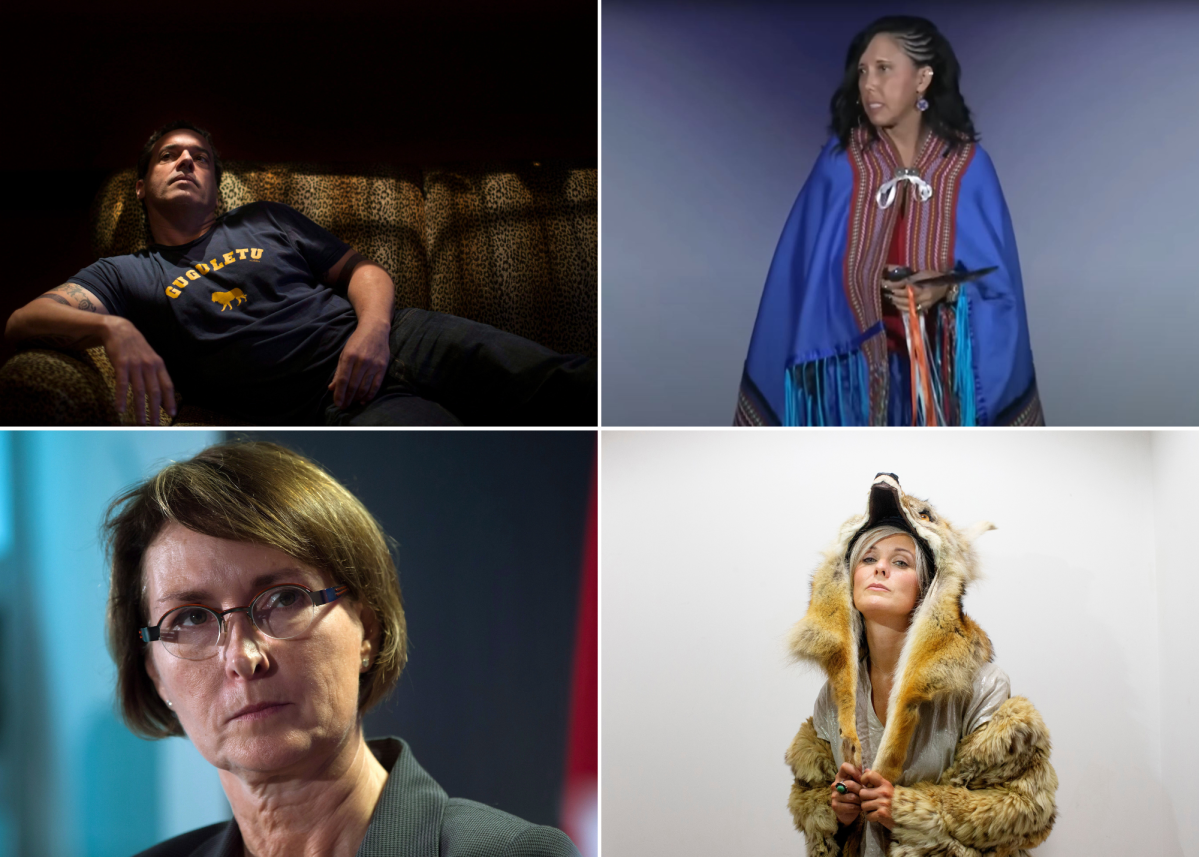Looking for more Indigenous news? Find our stories here.

If you’ve been online over the past few months you may have noticed a word more and more people are using: “pretendian.”
Not only in Canadian conversations, but south of the border too — with the death of Sacheen Littlefeather last fall — the discussion of who can and can’t claim Indigenous identity is becoming mainstream. But what does it mean when someone is accused of being a pretendian?
“It’s a tale as old as time,” said Veldon Coburn, an assistant professor at the University of Ottawa and an Algonquin from Pikwakanagan First Nation.
“There’s always going to be someone opportunistic and unscrupulous that will try to pull the wool over the eyes of everyone.”
The term “pretendian” is used to describe someone who claims to be Indigenous, but isn’t.
A pretendian might claim their great-great-great-grandmother was a Cherokee princess. They might broadly say they’re Indigenous — which is an umbrella term for First Nations, Inuit and Métis people — but are unable to be more specific as to how. They could also have a tenuous and very distant link to an Indigenous relative, or have no ancestry at all.
The term has become popular in recent years in Canadian pop culture. In 2016, author Joseph Boyden’s heritage came into question after he claimed to be Métis, Mi’kmaq, Ojibway and Nipmuc and faced a storm of criticism from Indigenous people who said he is not part of any of those communities.
In 2017, Boyden penned a piece in Maclean’s defending himself, saying he had “spit into plastic tubes” for a DNA test that showed he’s a “mutt” with some Indigenous blood.
Last October, former Saskatchewan judge and B.C. children’s advocate Mary Ellen Turpel-Lafond’s claims to be a “treaty Indian of Cree ancestry” originally claiming connections to Norway House, later Muskeg Lake Cree Nation (her husband’s community), her claims were found to not match the historical record, following an investigation by the CBC.

Turpel-Lafond maintains her identity, though she is no longer a law professor at the University of British Columbia and has returned some of her honorary degrees.
Some organizations have rescinded their degrees or awards, with the most recent on Thursday being the BC Civil Liberties Association.
“Turpel-Lafond’s misrepresentation regarding her purported Indigenous ancestry must also be contextualized within the greater, widespread pattern of Indigenous identity fraud, and the severe harms that it causes,” the association said in a statement.
UBC declined to comment on its handling of Indigenous self-identification for employees or whether its process would change.

Get daily National news
Other recent subjects of investigation include Canadian filmmaker Michelle Latimer, whose claims of being Algonquin with ties to the Kitigan Zibi First Nation were also disputed by the CBC in 2020.
Latimer later wrote on her blog that she’d hired an academic who found her to be a “direct descendant” of a vanished community of French Canadians living together with Algonquins.
Carrie Bourassa left the University of Saskatchewan after a 2021 CBC investigation claimed she had no Indigenous ancestry despite her claims to be Métis, Anishinaabe and Tlingit.
She maintains her Métis ancestry, and has denied taking positions or funding from Indigenous people, saying her career has been built on merit.
Mary Jane McCallum, a Cree Senator from Manitoba, has called for a federal committee to study Indigenous identity fraud.
“People don’t really look at identity theft,” she said in a Feb. 16 interview with The Canadian Press.
“It’s almost like an invisible crime.”
Not enough Canadians realize the harm caused by people who claim Indigenous identity without proof, McCallum said, nor how some people with legitimate ancestry are still fighting for recognition under the Indian Act.
“There will always be those people that look into the gaps and … start to use indigeneity as a source of power,” she said.
Why are there so many pretendians?
Comedian and playwright from Curve Lake First Nation Drew Hayden Taylor is intimately familiar with the concept of pretendians. He’s been writing about them for years and his documentary The Pretendians explores everything from fake Indigenous art to pretendians’ tendency to be found in the arts and academia.
While many things weren’t surprising during his research and filming, Taylor said one thing stood out.
“The vast majority of people who have been outed, and I’m using air quotes, are usually smart, intelligent, talented people that could have made a very successful career for themselves without claiming to be Indigenous,” he said in an interview with Global News.
“So I’m trying to figure out, why? Why did they latch onto (a claim of Indigeneity) when they didn’t need it?“
He’s come up with three reasons: belonging, financial benefits and family lore.
“First, everybody likes to belong, right? … They like to belong to a group of people that have similar concerns. And let’s face it, being Indigenous in this day and age has a certain amount of exoticism and appeal to them,” he said.
“The second is obviously certain financial benefits, from getting cheap gas or cheap cigarettes up to the higher levels of writing books, making films, getting important positions in academia, society, organizations, companies, etc.
“And the third, in many ways, is the most common: family lore. You have a grandfather who says, ‘Oh yes, I believe my great grandfather had some native blood,’ and they tend to believe that and it becomes part of the family identity without anyone bothering to check it out.”
What can be done?
While universities, companies, grant offices and organizations deal with the growing awareness of Indigenous identity fraud and the need to take allegations around pretendians seriously, there isn’t a cut-and-dried answer on how best to move forward.
“You’re serving two masters where yes, status cards, etc., have been instituted by the government as a method of colonization, but there is a certain amount of backing to those to those cards in terms of heritage and stuff like that,” said Taylor.
“And yet I can totally understand people saying, ‘I don’t need a status card to be Indigenous.'”
Coburn has some ideas on how to root out a pretendian, knowing the lengths people will go to.
“Ask them to specifically identify their community. And you can probably look up their governance and perhaps make a brief inquiry. But then there’s also the fact pretendians are creating fake communities, too,” he said.
Last fall, Métis lawyer Jean Teillet published a report for the University of Saskatchewan exploring Indigenous identity fraud that many people in Indigenous communities have viewed as the gold standard for weeding out fakes.
Teillet’s report outlines the red flags to watch out for, and said it’s time for employers to move beyond self-identification and take steps to verify an Indigenous’ person ancestry.
“There may be a more relevant word than identity,” Teillet wrote.
“Citizenship, relationship, and kinship speak to who claims a person, not who the person claims. Look for the markers of identity – a name or clan, responsibilities, the ability to give gifts, and accountability.”
Most Indigenous people agree institutions need to go beyond believing a surface-level claim and not be afraid to ask for proof.
Added Taylor: “The concept of how important family is to First Nations communities, that’s usually the first thing that does in a pretendian — the lack of real, substantial family connections.”








Comments